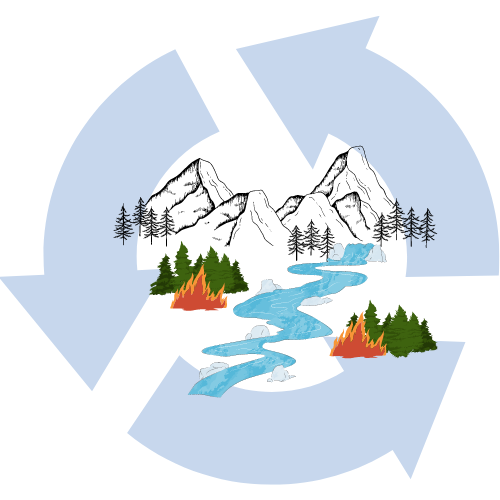Ah, the glorious signs of spring! The snow is melting, and streams are flowing. Isn’t it magical to have all the picturesque streams flowing through Whistler? But wait, there is more to these streams than just scenic beauty and recreation. They can give us hints about the upcoming fire season!
Every stream has a unique annual rhythm, resulting from the amount and form of water that flows into that stream system. Both short-term weather and long-term climatic patterns, like the familiar El Niño/La Niña, can help us predict how much water will be flowing and where it is coming from. This past winter, for example, we all experienced the effects of a strong El Niño winter with milder temperatures and less snowfall than typical—and boy, did the snowpack reflect it!
The health of Whistler’s many ecosystems relies on these annual rhythmic patterns of stream flow. When these patterns shift, nearby ecosystems feel the ripple effects. We call these fluctuations in stream flow hydrologic regimes, and in B.C., we categorize them based on those most influenced by rain (pluvial system), snowmelt (nival system), or glacial melt. In Whistler, our streams are mainly influenced by snowmelt and glacial systems giving us higher flows in spring through early fall and lower flows in the winter. The melt of annual snowfall precedes the melt of glaciers, allowing for a consistent supply of water during the warmest months of the year.
Moisture in plants, soils, and the atmosphere are all important factors in maintaining a fire-resistant forest. In the winter, many plants die back or go into “sleep” mode, but come spring, they wake up thirsty, ready to take up and hold water. Unfortunately, during February’s early rainfall, the plants weren’t quite ready to drink it all in, so much of the water that usually comes as snow, which is vital to the forest, washed away.
Consistent water supply keeps forest soil hydrated, with soils acting like a sponge that filters and retains water and nutrients. If our snowpack runs dry earlier than usual, our forests’ ability to act like a sponge will decrease. This could lead to parched soils, from the topsoil layer deep into the ground, and drought-stressed plants, creating perfect fuel for wildfires.
Speaking of wildfire fuel, the type and availability of it greatly influences both the intensity (amount of heat energy produced) and severity (amount of plants/infrastructure burned). An increase in dead plants, or dry logs, provides more easily ignitable fuel, and low, dead branches can potentially turn fires into canopy-climbing monsters, spreading faster than you can say “Smokey Bear.” Dry soils turn surface fires into a sprinting race, and can even lead to “zombie” fires that smoulder underground throughout the winter and can reignite the following summer. Scary!
The connection between winter conditions, stream flow, the upcoming fire season, and the future of our mountain sports are deeply entwined. With less moisture in our forest’s soils, combined with dry, warm conditions, the stage is set for wildfires that are not just bigger, but nastier, too. And this season’s change in hydrologic rhythm isn’t a one-off; as nature’s patterns are changed climatically from the “norm,” our forests will likely become hotter and drier, making each wildfire season a bit scarier than the last.
Naturespeak is prepared by the Whistler Naturalists. To learn more about Whistler’s natural world, go to whistlernaturalists.ca.




